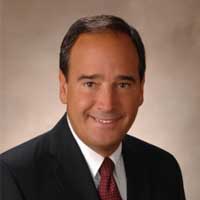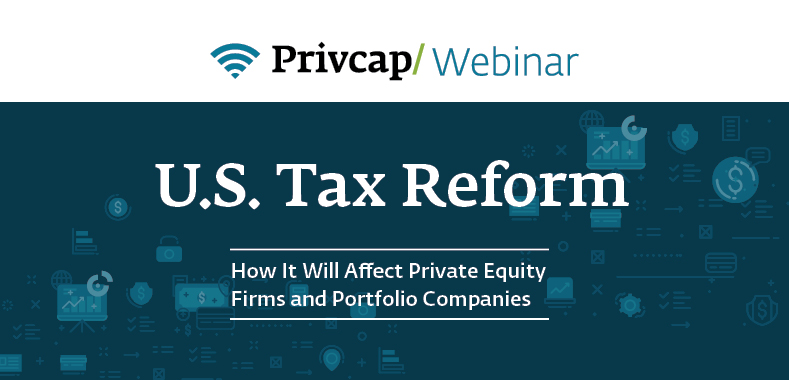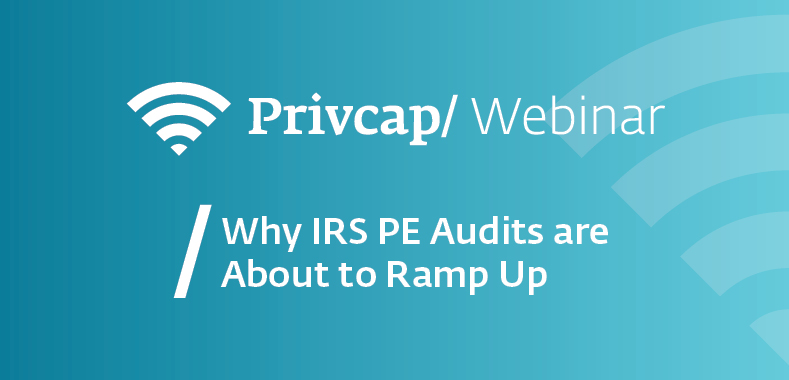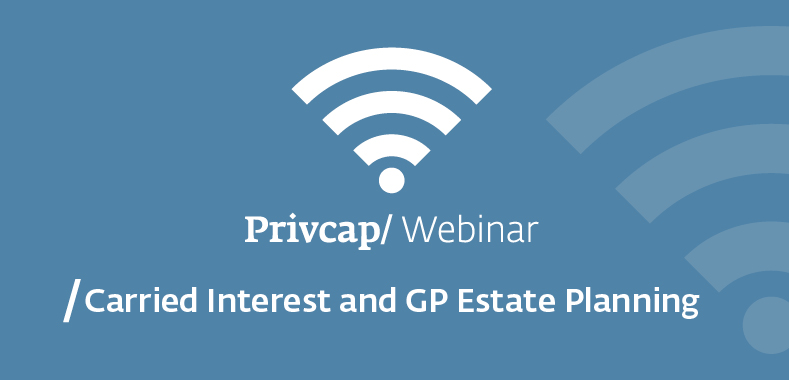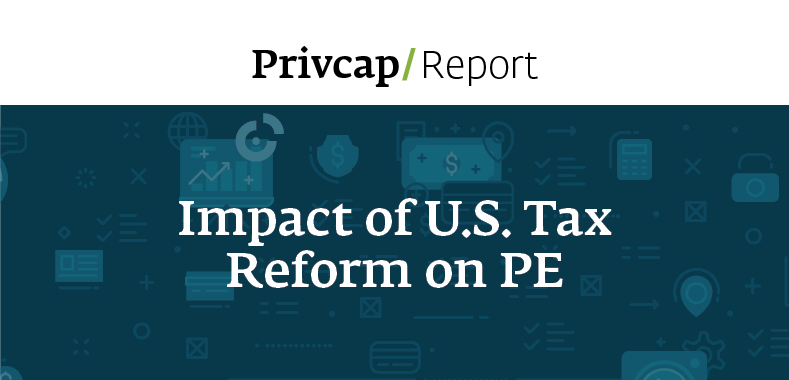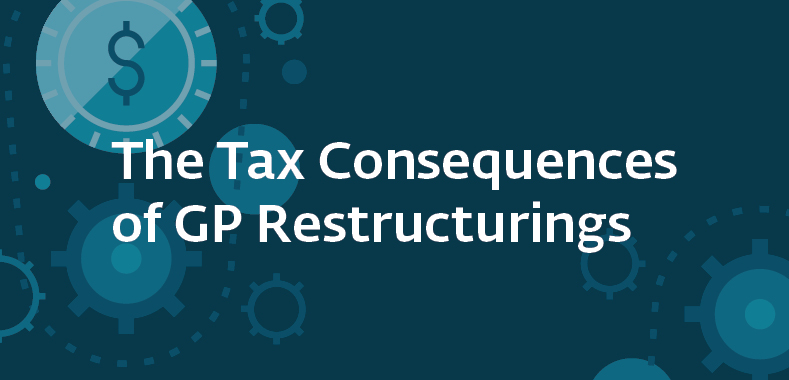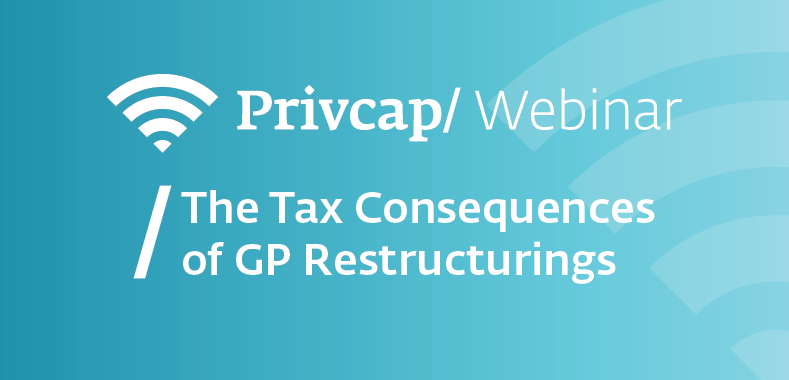
On-Demand Webinar: The Tax Consequences of GP Restructurings
In this 45-minute on-demand webinar, experts from RSM and Withersworldwide explain why GP restructurings are at record-setting levels in the current market, and more…
Transcript Download Transcript
On-Demand Webinar: The Tax Consequences of GP Restructurings
David Snow, Privcap:
Hello and welcome to a Privcap webinar. My name is David Snow. I’m a co-founder and CEO of Privcap. Today, we’re going to be talking about a very hot topic, which is GP restructurings and their legal and tax implications. We have a stellar group of experts that are going to walk us through this complex but very important topic. I’m going to ask each of them to briefly introduce themselves, starting with David Guin.
David Guin, Withersworldwide:
Hi, this is David Guin. I’m a partner at Withers-Bergman and I spend most of my time doing fund formation and acting as general outside counsel to fund managers and family offices. I will be your non-tax participant on the call because I counted this primarily from a corporate restructuring standpoint.
Snow: Great. Can we hear from Lindsay, please?
Lindsay Hill, RSM US LLP:
Hi, I’m Lindsay Hill, I’m a director with RSM. I’m in the valuation group and I’ll be speaking from the valuation prospective for private equity and hedge fund interest, and also a non-tax person on the call today.
Snow: Great. Over to the tax side, can we hear from Matthew Talcoff, please?
Matthew Talcoff, RSM US LLP:
Sure. Hi everyone. Glad to be with you. I’m Matt Talcoff. I’m a partner with RSM in our tax practice and I work with high net-worth individuals, including many of you who own interests in hedge funds, private equity venture capital. I’ll be commenting a bit today on some of these proposals in our house bill, which I’m sure excited to be talking about.
Snow: Great. Finally, Tom Lenz from RSM, please.
Tom Lenz, RSM US LLP:
Hi, I’m Tom Lenz. I’m located out of our Chicago office and I’m a partner heading up the private equity tax practice. I also represent the firm in investment management committee and partnership committees. I also do a fair amount of writing for the Journal of Penzu taxation. We do the private equity texts corner for the publication.
Snow: Great. Why don’t we start with a bit of a stage setting? When talking about GP restructurings, we’re really talking about a very broad range of transactions done for number of different reasons. David Guin, can you walk us through what some of these GP restructurings look like and what categories they fall in.
Guin: Sure. The first one, perhaps the most common one, is sort of a recutting of the economics among employees of the firms—the fund managers. That can happen because you have new people coming in and you have people leaving. So, there are number of ways that could happen. But it usually is [that] it’s the same group of people recutting the economics among themselves. In that regard, one of the things you should be concerned about, especially if you bring new people in, is to be sure you are keeping a count of what we call “profits interests.”
We’re just going through this with a client now, where they’re bringing a new person into their fund management complex and we’re having to structure it so that he’s not getting any current value by bringing him into the fund. So, we’re having to high loft the current value in the GP in making sure he’s not participating in that. If he doesn’t or if he were to participate in that, he would have tax issues, because he would get taxed on the current value of the interest he was receiving without having to pay for it.
We’re also seeing an increasing number of GP rollups. In a GP rollup, you typically have a firm that has a big distribution network and they’re going out to smaller fund managers and either requiring all or usually controlling interest in the GP of a smaller fund to bring it on their platform and, in exchange for their promise to bring the greater distribution network that they have to the smaller fund managers, the firm that’s doing the rollup expects to take all or a portion of the economics of the GP. That requires a restructuring of the holdings of the GP.
Finally, we do see some cash-out restructurings. That happens primarily when you have a senior person at the firm who decides they’re going to retire and they need to be paid out for the value of their interests. This requires a restructuring usually because the firm needs to either generate the cash to pay them out or to recut the economics of the GP so that the person who is exiting the firm gets the appropriate value of the GP as of the time they left.
Snow: Great. Over to the tax experts. In considering these transactions, what are the biggest concerns your clients have or the biggest questions you get about doing these transactions in a tax efficient manner?
Lenz: This is Tom Lenz speaking. A lot of times, with respect to the profits interest—bringing on some of the younger people up in the fund—I’ll address that. There’s a big issue regarding their status as to whether they’re an employee or a partner. I know there was one mention as far as when you bringing and splitting up the economics, etc. Typically, they’re an employee and then they become partners, so as far that status goes, that’s a big issue and something to deal with.
As far as the IRS is concerned, their position is that the former couldn’t be a partner and could not be an employee anymore—[he or she] wants to become a partner and so the IRS’ position is that you cannot have dual status as an employee and a partner. That’s probably one of the bigger issues.
There’s the valuation issues, of course, on what’s the value. Then, the other issue is profits interest in general. The one thing I want to comment about profits interest and granting a profits interest is that there’s this conception or notion out there that profits interests just aren’t taxable; the reality of it is that that’s not necessarily a true statement.
Profits interest theoretically would be taxable, but there’s this revenue procedure that allows—it says, “These interests are just too hard to be valued, so therefore, as a matter of convenience, as long as the partner has zero value issuance from the liquidation standpoint or from a waterfall, we’re going to say that interest has a zero value.” Theoretically, it’s taxable to that partner, but it has zero value, so it has no income. So, one of these requirements to have this procedure applied is [that] there’s this two-year period when the general partner would then need to hold on to their interest for at least two years.
So, if there’s a disposition within two years of a profits interest being granted, then you’re no longer under the safe harbor. We see this tripped up a lot, where someone transfers a profits interest and it’s within this two-year period. Now, all of a sudden, they’re not within this safe harbor, so therefore you would go back to when that profits interest was issued and what really was that value? Did that interest have value? So, that’s a big issue with respect to the profits interest.
Snow: Great. There’s a lot more to discuss with regards to taxes, but I want to pause and move to the issue of valuation and hear from Lindsay Hill. Lindsay, we know there’s a whole range of GP restructurings that are taking place out there that involve not only the funds but the management companies that control the funds. So, talk about the valuation requirements and what your approach is for those different entities.
Hill: Yes, absolutely. I’ll touch on that and I also just wanted to touch on the profits-interest discussion a bit as well, because that offers up a whole host of valuation issues. I think the important thing to keep in mind in restructurings is what is being impacted and where do we need to understand the value? Within the fund structure, there are different areas where we have value: it might be in the GP interest or the carried interest or in the LP or in the underlying management company.
In the context of valuation, that management company is the operating entity; it’s where we’re getting the management revenue. It’s the expenses and it’s the investment in the company, which really lends to some of your traditional valuation methodologies and that can’t be ignored. Even though, obviously, the GP interest is a significant value and the LP’s are important as well. But you just need to keep in mind what the subjects of the valuation are and make sure you’re addressing that valuation appropriately.
Continuing on, I did want to talk about the profits interest and the valuation issues with those as well. As it was mentioned, it’s not necessarily a taxable event upon the grant date. The profits interest give you a right to appreciation in value of the company. But one thing from a valuation prospective that I like to point out—at least to the people who are receiving these profits interest—is that it’s important that you do have an appropriate value on that underlying interest of that profits interest so that the holder of it is getting the appreciation value. If that hurdle, per se, is set too high, then they’re not really gaining from that appreciation. And if it’s too low, there’s kind of a beneficial notion there. So, it’s really significant that you understand the terms of that profits interest—those hurdles or any other vast seen provision.
The other topic on that, and this might be obvious, but profits interest is very similar in nature to carried interest in that it’s reflecting future appreciation and value, but the concept is very different. I just wanted to make sure that that was clear to the audience.
Snow: Great. Let’s follow up with a brief legal question for David Guin. David, in what cases are key man clauses important to look at and in what cases is investor consent necessary?
Guin: Sure. One thing we’re always looking at when we’re doing a GP restructuring are the key man provisions. Often, they’re not a problem but they’re something that needs to be taken care of. A key man provision in fund documents will normally identify one or more individuals and it’ll be structured in one of two ways: either it’ll say that those one or two individuals need to be making the investment decisions for the fund or it will say that they need to be devoting substantially all of their time and attention to it. So, as you’re bringing people in and out of the management companies, you need to be looking at the key man provisions and determining whether or not what you’re doing would trigger those.
A lot of the key man provisions you see in fund documents today do allow the fund manager to substitute in new people, often with the consent of a LP committee. The LP advisor committee is something that can be usually worked around, but if you’re thinking about a GP restructuring and you do have any key man provisions in your fund documents, be sure to look at them. It may require some advanced planning to make sure that you satisfy those and don’t end up triggering key man provisions.
What happens in a key man provision, usually are one of two things: either they allow the investors to redeem without respect to any gates or holding periods that would apply or typically in a private equity fund, it will stop the investment period at least for some period of time. So, they are usually things that can be worked around, but you do need to take a close look at those and make sure that you’re planning based on the exact facts of what the restructuring look like.
Another issue that often comes up is whether investor consent is required. As you may be aware, if the fund manager is an SEC–registered investment advisor, there’s a provision in the investors act that says you cannot transfer a contract without client consent. And the SEC has taken the position that a change in control of the fund manager constitutes an assignment of the contract if you actually have a change in the management in control of the fund manager.
For example, you could be transferring interests from an individual to a trust for that individual and transferring more than 50% of the ownership of the fund manager, but because the same people would be running the fund, it wouldn’t really be a change that required investor consent. However, if you are in a GP rollup where you’re offering transferring control of the fund manager to the entity that’s doing the rollup, those are the types of things that would constitute an assignment of the underlying investing management agreement between the fund and the fund management company.
The way this has been looked at has changed substantially over my time in practicing law. As you know, in the context of a fund, the management agreement is between the fund entity itself. Usually controlled by a GP that is also controlled—the same people control the fund manager. Early on in my practice, people generally took the view that the general partner—i.e., the fund manager—could consent to its assignment on its own. That’s much less common today.
Even if the documents don’t specifically require it, in my experience, if there’s going to be a change in control of the investment manager, people are often going out to the LP’s to seek consent to the transfer so that they’re sure they’re not violating this provision—the investment advisor act. [There are] two technical legal points that you need to keep in mind. People would normally think to look at their key man provisions, but do give yourself enough time in advance to make sure you’re planning and doing all the things you do need to do. But a lot of people don’t really think of the investor consent question, which is something that falls out of the investors advisement act. So, you’ve got to keep that in mind as well.
Snow: Great. How about a follow-up question for Tom Lenz? Tom, when forming a fund for even restructuring it, there’s often the expectation from investors that there should be a GP investment in the GP’s own fund. Are there alternatives to that? How do you structure those from a smart tax perspective?
Lenz: Right. So, there is an alternative: it’s actually putting in money. There’s the concept that a lot of people on the phone might be aware of and that’s called fee waiver. What happens there is that the managers are generally going to receive their two and 20 and they’re also investors in the fund. But what they would do is waive a portion of their fixed fee—their 2% management fee—and instead have a profits interest.
Let’s say, by way of example, that you had a $100–million fund and you had a 1% commitment left, the $1 million to the GP would put in. Well, certain documents give different amounts, but you could waive a certain percentage of that as far as fees. So, instead of receiving your 2% management fee of that $100 million, which would be $2 million, maybe you’ll only receive $1 million. Instead of taking that, the money of a $2-million fee, we’re talking about the $1 million that capital that you would contribute, you have to pay ordinary income tax on that and then contribute it right back into the fund.
The idea would be to just waive that, because it’s just an in–and–out right from an efficiency standpoint. You would waive that fee in exchange for a profits interest. The IRS got wind that this profits interest fee-waiver technique was being used—it had been on the down low in the industry for a while; the IRS tried to shut this technique down with regulations that were issued in 2015. Basically, the IRS… somewhat allowed it actually, a fee waiver, but there were certain conditions. The main condition was that they wanted the special profits interest again to earn back the fee waiver; that you had to have that subject risk.
In other words, it wasn’t that you were going to get this extra $1 million back or, what have you—it had to be that the fund would need to be profitable over its life. At least $1 million profitable so that the general partners are actually putting that money at risk. That was really the main requirement.
The second requirement that they have in their regulations was that you need to have the ability—again, the profits interests there—also putting that at risk. Anyway, that’s the concept of the fee waiver—profits over the life of the fund and that fee, that second thing (I’m sorry I lost track there), was that money, the fee waiver would have to be paid back to the entity that was getting the profits infer.
One of the problems before was that people were having the management be paid to the management company and then the special profits interest going to the general partner. What the IRS said was that that violated the two-year rule that I mentioned earlier, where you can’t have a disposition over profits interests within two years.
What they were saying was that can’t amount to the managers disposing of their interest. So, then, you rate their post-rate that wanted to shut that down. Now these regulations are not effective until the rates are still final. And the IRS just book off the finalization of these regulations off their regulation guidance project. This has to do with the government now trying to cut down on…new regulations to come out. I think there need to be two killed before one new one comes out.
I think the IRS believes that fee waivers have somewhat been shut down, because we’ve been seeing less use of fee waiver clients becoming a bit more apprehensive about using that technique. So, I think the IRS doesn’t want to so-called waste a final regulation on fee waiver, when they feel like it’s been so much shut down. So, we see the opportunity still being available out there. I think fee waiver is still a viable option; it’s on the radar stream now, but if it’s structured properly, it still works from a tax perspective.
Snow: Great. I’d like to remind our audience that we’re going to save some time at the end of our webinar for questions from you directly. So, please think of some good questions for our experts and you can send them in on the webinar platform. We do want to get to the tax reform in place on Capitol Hill. But before we get there, just one more follow-up question about an aspect of a partnership economics that has to do with guaranteed payments. What do people involved in a GP restructuring need to understand about how to handle guaranteed payments for tax planning?
Lenz: That could be to me. Tom Lenz speaking again. I think with guaranteed payments, there’s nothing too special about them. I mean, guaranteed payments are payments that a partner receives in exchange for capital or for services, so I think the guaranteed payment issue gets down to generally it’s just the sale repayment of treating the partner as a partner as opposed to an employee. So, they’re going to be receiving guaranteed payments.
There are some concepts with shifting of profits with targeted capital econ agreements—it’s probably on the scope of this discussion but there are certain situations where, if you have a preferred return as an investor, some of the people putting money in may be getting a preferred return. If that return is senior to the existing partners or the common numbers, then that return, even though it’s not paid, could be considered a guaranteed payment. That means that, even though the entity or partnership that you’re investing in isn’t making profit, you could have this deemed guaranteed payment, so to speak, and have phantom income.
From an investment standpoint, the one thing with guaranteed payment is, again, the situation where you have a preferred return is going to be senior to someone else’s capital in the partnership and whereby you may have a phantom income, even though the entity itself that you’re investing in is not profitable.
Talcoff: Yes. If I may just add one other thing on that topic; Tom, you may know as well. We are seeing more and more funds that get tiered structures as well for some of their employees who are getting some interest, where they don’t want to have to deal with some of the issues with respect to guaranteed payments and different rules with respect to how they pay their estimated taxes. We are seeing some tiered structures come into play in the restructuring that’s taking place, whereby you find that keeps certain individuals treated more like an employee as opposed to a member of an LLC or a partner in a partnership as well. That’s to avoid the issues again with payments as well as some self-employment issues.
Guin: From a legal standpoint, we’ve seen some of that as well. We’re seeing a lot of our clients go to—rather than treating people as partners, they are giving them a contractual right that looks more like a phantom equity right then actually making them a partner.
Lenz: Yes, and I’ll jump in here. As an overall premise, as far as dealing with fund formation and structuring and deal structuring, there are lots of different ways to structure a lot of these transactions, so I think it’s important that you’re talking to your legal advisors and the accounting firm. Because generally, there’s a tax efficient way to do what you want to do, but there’s no magic box where one situation fits all. So, it’s considering, as David’s pointing out, the legal issues what needs to happen, what sort of objectives of fund management, etc. Then, basically, we work with our toolbox, but coming up with a most tax–efficient solution. I think that’s the overriding comment here that I’d like to chime in on.
Snow: Great.
Lenz: For example, like the employee thing that was just mentioned, some will like to do that. Others don’t want to do that for another reason. What may be good for one fund may not be good for another.
Snow: Although it’s a very big topic, since we have the experts assembled here, why don’t we ask you about what you’re following most carefully in regard to the tax reform effort that is making its way through Congress? Matt, can you give an update to the folks listening to this webinar, all of whom deal in private partnerships and phantom entities? What are you following most carefully?
Talcoff: Sure, David, thank you. Yes, there’s so much stuff out there. There was not a lot of detail at first. There’s some more detail now, but I guess what I’m focused on—or what our firm’s focused on—is trying to understand the different options and the alternatives that might be considered by some of the folks on this call, if some of these proposals in the bill would actually become law. For example, there is a topic about what would be the tax rate of a C Corp versus a flow-through entity. There is in the bill that the corporate tax rate drops to 20%, whereas the tax rate for flow-throughs, depending on the type of flow–through, could be anywhere from 25% up to 40%. Depending on whether you have a service business, whether you’re active or passive in the fund itself, or how much invested capital you have. So, I think everything we’re talking about today on this call about restructuring is absolutely critical to think about.
If the bill passes with some of these things in it, we might be having totally different views on how we might want to restructure some of our investment partnerships going forward. One of the things…we were talking about was [that], in the past, we’ve tried to get folks to be active in said fund because there may have been really good reasons why we wanted them to be active. If, in fact, for some reason, the flow–through income to our past investor would all be taxed at the lower rate, say, for example, 25%…which is in the House bill now, we might want folks to become passive again.
I had one client yesterday say “Thank you for my way to be able to get earlier retirement. I appreciate that.” That’s one of the things we’re thinking about. Certainly, carried-interest legislation is a topic that became very important to be thinking about a couple years ago and even more important this week. As you all probably know, the House bill that came out a week ago has already been marked up with some additions this week, which included carried-interest legislation.
There is a discussion about having a holding be needed for three years, in order to get the favorable tax rate, as opposed to the current one-year holding that exists. And there’s complications in trying to administer that, if that goes through. For example, how do you think about it if you had somebody new admitted to your fund, but you had a portfolio investment that was held long-term and was sold and flowed up through the K1’s? Is that going to be considered part of the lower tax rate or the higher tax rate? What if two of us, David, you and I are at the top level of a fund, and I came in a year ago and you came in three years and a day ago, and we sold again a portfolio asset and its long–term capital gain flows up, how’s that all going to be treated? So, there are a lot of unanswered questions still that we need to think about, but those are some things we’re following. In addition, for this group, it’s important to think about how we’ll model stuff out at this year-end. In the bill right now, there is this proposal that state tax deductions would not be allowed.
If that’s it for folks who are living in higher state-tax jurisdictions, might they want to be thinking about how the flow-through income would be coming to them next year versus this year? Should they be accelerating additional state tax payments at the end of this year? Should they be considering donor-revised funds to make more charitable contributions this year?
In addition, one of the important things I’m following and our clients are following is the discussion about repealing the alternative minimum tax. There is an entity this year—if it’s repealed next year, how do we think about any payments that we make now versus next year? Then, in addition, for the folks here who have investment partnerships that are again having operating businesses as their portfolio companies, there are provisions that allow immediate expensing for assets that are placed in service after September 27, 2017. We should be thinking about whether or not—if we believe that’s going to pass—there are ways to reduce our income this year by placing some service assets now? Or doing accounting method change to accelerate deductions into this year and push out in commencing next year, when maybe there will be more favorable rates for that?
Those are some of the things that we’re following, David. Anyone else on the line is welcome to comment as well on that.
Snow: Matt, Tommy Wright here. One of the things I think we also need to look at, on an income-tax planning side, is for those folks who are subject to the alternative minimum tax in 2017 with the tax rate at 28%—that yields a great opportunity if you’re in that circumstance to accelerate as much income into that 28% bracket as is possible, because that’s much better than the alternative 39.6%. So, for those who are subject to AMT, acceleration of income is an idea. Roth conversions—anything you can do to generate income to get it taxed at 28%.
Talcoff: Tommy’s absolutely right. And let me add onto what Tommy just said as far as accelerating income. If you’re already in AMT this year, that might also allow you to increase your state tax deduction if you’re living in one of the higher state places and if you think state tax deductions won’t be allowed next year.
You actually get a double benefit by accelerating income and paying the state tax now in that type of scenario. But, David, those are some of the things we’re clearly thinking about. Tommy mentioned this as well—as folks may know, in the proposal (or in the bill, I should say), it’s proposed that we would have a doubling of our exclusions for a state purposes up to $11 million per person.
So, the stuff that Lindsay spoke about earlier with respective valuation of interest that we might transfer in our funds—that becomes even more critical because getting a valuation discount and having an increase in the state exclusion, to $11 million per person, might want us to move more assets to the next generation and avoid tax, especially if, in the future, some of these provisions would go away again.
Snow: It’s time to move to questions from our audience, but I understand that, Tom Lenz, you have a question for your colleague Matt.
Lenz: Right. Matt, this is Tom. This all seems to be moving quickly and I think I read somewhere that incentive markup might be no later than this Friday or Saturday. So, what’s the timing of when this law would be effective and is there still time? It’s already November 7th or 8th. I’m not sure what the date is today, but you know it’s getting close to the end of the year. So, it sounds like maybe it’s not too soon to start thinking about this and, even though a lot of this—the language and drafts and things are moving pretty quickly, we’d have to start lining up the strategy. What are your thoughts on that?
Talcoff: Yes, Tom. Thanks. Absolutely, absolutely yes. This is presumably moving fast through markup, as Tom mentioned. We can all try and guess whether or not there will be sufficient votes in the House and the Senate to get something passed, but we have to think about all the different alternatives, as Tom mentioned there, for year–end planning. Talking about it probably yesterday is the best thing.
I’ve been reaching out to clients, to determine different models that we want to look at for year-end because we don’t want to get to December 20th—hopefully a lot of you are going to be going on vacation to enjoy the holidays—and we don’t want to have last–minute plans that we’re not prepared to execute on with respect to cash-flow needs. So, Tom, you have planning now [that] is absolutely critical. We may not know the final answers, but we certainly know some of the levers that might be pulled with respect to all these different things in the House bill and the markup.
Lenz: From what I’m hearing, I think anything retroactive is pretty much not totally off the table, but we’re talking about 2018—that’s what I’m hearing and that’s although—
Talcoff: Yes.
Lenz: Even if they got something done even in the first quarter, it still could be retroactive to January 1st, 2018.
Talcoff: That’s correct, yes. That’s what we’re hearing as well. There’s been some politicians who have strongly come out and said that they would like to see like the individual reform happen for 2017 retroactively. Because they believe that, once we get to April 2018, which is only a few months away, people could actually finally see what that benefit would be to them, as opposed to waiting another year until April 2019 to see it. But I’m of the opinion that’s going to be really difficult to happen.
With all the different deficit implications and so forth, I think the best estimate is that it would be next year. Again, some of the things are impacting 2017, like the cap spend, which, if you put into service to cap item this year, you can expense it if it’s after September 27 this year (2017). So, we’ll have to continue to monitor it, but I would agree. Next year’s probably the more likely scenario.
Lenz: OK, thanks.
Talcoff: It sounds like the action on Capitol Hill is going to continue and we should turn to all of you for regular updates. It’s now time for questions from our audience. We already have a few good ones, so let’s move through these and keep an eye on the clock. We have a question about blocker entities. Maybe this is one for you, David Guin—can anyone share an example of a blocker entity being put to use?
Guin: I’ll start out. A lot of these things are good and, by tax considerations, I’ll give a couple of examples and then turn it over to the tax folks to give us their thoughts. Obviously, you more often see blocker entities in irregular fund structures that are set up for the LP’s, but we do have a situation that we’re working on now where we’re setting up a blocker entity for a non-U.S. person who in coming into the GP entity and the types of questions we’re considering for that are whether that blocker entity ought to be onshore or offshore. Usually, it would be—we’re considering either a Delaware cooperation or a Cayman company.
The things we’re struggling with there are the interplay between withholding rates on corporate dividends because you can’t really structure it as you often would a blocker entity, for example, in a private equity fund where you’re not going to have to worry about the dividend withholding because you’re going to take the money out as liquidating distribution. And playing that against whether or not branch profits taxes would be applicable if you were using an offshore company as the blocker in a GP structure. So, that’s one tax question we’re dealing with and it’s really the tax considerations that are diving the question structuring.
The other thing we’re dealing with is whether that blocker entity ought to be leveraged or unleveraged. As you probably know, a lot of times blocker entities will end up being leveraged in order to take advantage of the deductibility of interest payments and the fact that the payments on the debt aren’t subject to the dividend withholding taxes. In that question, we’re really dealing primarily with the ratio of debt to equity. And whether we’re going to try and use a 60/40, which is safe harbor for the income-stripping rules, or we’re going to leverage it more highly to use something more like a 30/70 or 35/65 split.
Those are the considerations we’re thinking about because they say they’re primary tax-driven. Perhaps one of our RSM folks can comment on how they do those things?
Lenz: Yes. I’ll chime in here. If people are on the call saying, “I think David mentioned onshore/offshore,” just so you know, there was a case that just came down a few months ago. Recent magni sight is named the case but I think before there were offshore blockers used. That’s where, if you’re thinking out there, “I know what this is all about and this is the way to go with it,” just know that there’s a new case out there, so the landscape has changed a bit because of this case.
That may allow you to use more of a decision of whether you use a U.S. or an offshore blocker. But, as far as that goes, about blockers, we use it to block—there are other issues with flow-through income where that doesn’t want to be. Sometimes, some funds don’t want the flow-through income. They’d rather have a blocker entity to block the income, pay the tax and then have distributions come through out of that blocker entity.
For those types of funds, there are ways to restructure the partnership down below. You have some exits, so you just need to bypass the blockers. That’s one strategy; even within these blocker strategies, there are sub-strategies. That’s another issue with respect to the blockers.
State tax reporting can be a problem if you have LLC’s flow-throughs, so that’s why you might want a blocker set up—so the blocker can handle all of the filing and pay the taxes. Again, with that type of structure, you would want any exits to bypass the blocker, which would mean either acquiring a sale of a blocker stock or restructuring the LLC down below so that any gains could be bypassed by the blocker.
Snow: We’ve got a few more minutes and I’ll throw in another question from an audience member who says, “In the event of a partner leaving a fund—and the economics that partner reverting back to the fund and to the individual partner—how does that work from a tax perspective?”
Talcoff: Tom, I think what we’re asking here is that you have someone who owns an interest in a fund, they’ve left the fund, so the fund itself has taken back that interest. So, the question is the treatment to the fund itself and all the remaining partners. Is that correct?
Snow: Yes. That’s the question from the audience member, saying “Is it taxable upon receipt by the partnership?” If it is, allocable pro rata to existing partners, it’s taxable to the partners. Just an overview of how that would work.
Talcoff: Got you. Tom, do you want to comment on that?
Lenz: Sure. As far as going back to the fund, that wouldn’t be a taxable situation going back to the historic or existing partners. Typically, what would happen is there’d be some kind of negotiated payout with respect to the partner who is leaving. So the dead point—there’s some issues regarding basis and gains to the exiting partner, but typically in that situation, there’s going to be some kind of negotiation. The fact that the other partners will be receiving theoretically more value because one of the partners has left is not a taxable event to those partners.
Snow: Great. This is a big topic and an ever–changing topic, so I really appreciate the expertise you’ve shared with us to all of our presenters today. I’d like to remind our audience that this webinar will be available in playback mode at privcapdemo.com. They will also be made available as a podcast via our iTunes channel and we will be creating a digital report based on the transcript of this conversation, if it’s something that you want to go over again or share with your colleagues or clients.
Thank you all very much for being a part of this. I learned a lot and I hope we can invite you back as the tax situation continues to evolve.
Talcoff: Thank you, David.
Lenz: Thank you.
Snow: Thanks, everyone, for joining a Privcap webinar. We hope you enjoyed it and we hope you can attend future webinars. Goodbye.
Guin: Thanks, David.
Snow: Bye, everyone.
Hill: Thanks.



